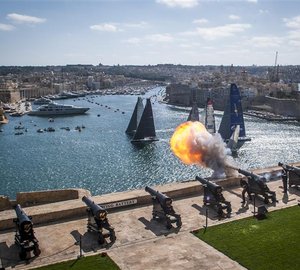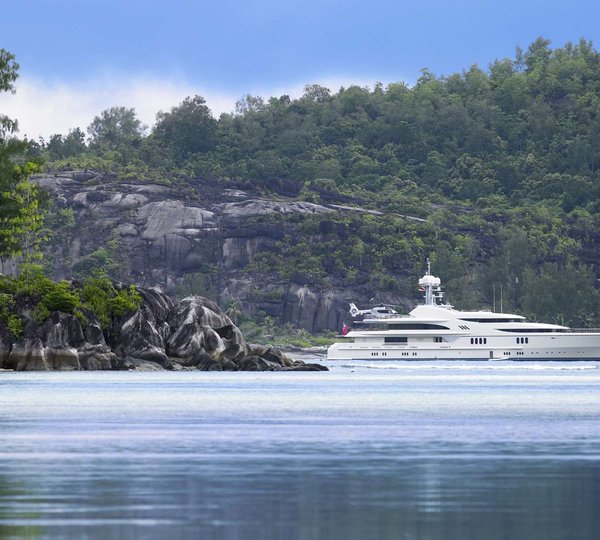This year’s Rolex Middle Sea Race obtained a certain spirit of offshore sailing. A competition represented by a frustrating search for an unstable wind was a proof of crews’ decisiveness, patience as well as determination. This was not split second, cut and thrust competing rather tactically strenuous, mentally arduous sailing with concentration and team spirit at the fore.
A record-breaking 83 international entrants from almost 20 countries and territories took part in this annual contest that commences and finishes in Malta, a measure of the event’s global appeal and increase in stature since Rolex began its involvement as title sponsor in 2002.
This 33rd edition witnessed the crowning of a new champion, representing a continent that had not previously provided a race winner, confirmed the recent dominance of the fleet’s fastest boat and most poignantly showcased the Corinthian spirit that inspired the race’s inception in 1968 and has been its prevalent feature ever since.
South African Pride
A new name and country was etched on the list of Rolex Middle Sea Race Trophy recipients when South African entry, sailing yacht Hi Fidelity, was confirmed as the event’s overall winner. Hi Fidelity finished the race in Marsamxett Harbour, Malta under violent thunderstorms and gusts of 37 knots, elements uncharacteristic of the tepid conditions she had witnessed throughout much of the 606-nm race.
Eddie De Villiers’ Welbourne 46 proved to be the week’s outstanding performer, completing the course that comprises an anti-clockwise loop around Sicily in little over four days and sixteen hours. The boat has form. Under the ownership of renowned sailmaker Neil Pryde, she claimed both outright victory and line honours at the 2010 Rolex China Sea Race.
“I’ve always been interested in challenging navigational races. This together with the Rolex Sydney Hobart was the race I wanted to do in my lifetime,” said an ecstatic De Villiers. “The whole idea of bringing Hi Fidelity to Europe was to do this race and it hasn’t disappointed us.” Effective tactical decisions enabled Hi Fidelity to maintain an ideal position in the fleet. “Patience is the greatest challenge in not making silly mistakes as you don’t have a lot of space in light airs to move. Once you’re committed to a certain position on the course, you’re going to have to live with that decision”.

Crew of Hi Fidelity yacht display the flag awarded to the overall winner of the 2012 Rolex Middle Sea Race - Photo by Rolex/Kurt Arrigo
Hi Fidelity yacht’s triumph is a genuine testament to team spirit. The bulk of De Villiers’ all South African crew have sailed together since childhood and are the embodiment of Corinthian sailing. The team includes Michael Joubert and Mark Sadler, professional sailors who represented Team Shosholoza, South Africa’s one-time America’s Cup representative. “When the going gets rough you want the right soldiers on the course,” added De Villiers. “Winning the Rolex Middle Sea Race is probably the highlight of my sailing career. It has been a wonderful experience and something I’ll cherish for the rest of my life.”
South Africa becomes the ninth different country to provide a Rolex Middle Sea Race winner.
Eventually Esimit Europa 2
Even before the fleet set sail, it was starkly evident the race record – set by American George David’s superyacht Rambler in the boisterous 2007 edition – was never going to be seriously challenged. “A race record in 2012 is very unlikely as it is looking like a light race. We will take the minimum weight onboard as possible,” explained Juan Vila, expert navigator of the week’s fastest yacht Esimit Europa 2, shortly before departure.
Motivation for the crew of the Slovenian Maxi was focused on equalling Italian yacht Benbow’s record of three successive line honours victories from 1975 to 1977. Untypical of her performance in the previous two editions, superyacht Esimit Europa 2 took a while to dominate. During a sluggish passage towards the notorious Strait of Messina, she found herself playing second fiddle to Niklas Zennstrom’s Mini Maxi yacht Rán 2. Rounding the volcanic island of Stromboli, the race’s defining landmark, she made a key tactical move to head inland. The 100-ft Maxi was able to stretch her legs at last and built up an insurmountable lead, eventually finishing seven hours ahead of Zennstrom’s British boat.
“It is hopefully the longest we’ll ever have to do!,” admitted skipper Jochen Schümann on arrival at the Royal Malta Yacht Club following 3 days, 13 hours, 33 minutes and 15 seconds at sea.

Luxury yacht Esimit Europa 2 claims line honours at the Rolex Middle Sea Race 2012 - Photo by Rolex/Kurt Arrigo
A united fleet
Notwithstanding the difficulties encountered during the race and the size of the battle to return to Malta ahead of the event’s cut off time for arrival, fewer than 15 crews retired: a measure of resolve in the face of adversity.
Trustmarque Quokka skipper Philippe Falle admitted: “Retiring never really crossed the mind. It was an intriguing race, a bit off the wall with the conditions and parking. The overall performance of team and scenery made up for everything. This is my favourite of the four (Rolex Middle Sea Races) I have done even though it was so slow.”
One of the main challenges faced was managing supplies. “We’re not expecting to see winds above 10-12 knots so we’re aiming to be as light as possible. We go through sails, spares, food and whatever we can to shave a key kilos,” said Rán 2 team manager Tim Powell before the start. During the final 24 hours of their race, the crews on both superyacht Esimit Europa 2 and Rán 2 yacht were rationing food, a measure of the strict regime onboard fully professional yachts. Schümann joked on arrival in Malta that a few packets of crackers were all the crew had left to sustain themselves.
Supplies onboard the majority of Corinthian crews – more readily braced for a week at sea and less concerned about carrying extra weight – lasted a while longer. Many enjoyed the slow but stunningly scenic passage around Stromboli with a hearty meal. For these teams, the increasing challenge in the final few days was fatigue.

Ran 2 yacht, superyacht Esimit Europa 2 and luxury yacht Stig rounding the mark at the start of the 33rd Rolex Malta Sea Race - Photo by Rolex/Kurt Arrigo
“It was very tactical. The crew worked round the clock. The boat was pushed to its optimum throughout,” explained Lee Satariano, co-skipper of the defending champion and the fastest Maltese finisher Artie. “This race was mentally tiring with constant sail changes, it didn’t let up,” added co-skipper Christian Ripard.
Another notable feature was how the fleet regularly expanded and compressed. “We’ve often got six or seven boats for company which is not often what you see during an offshore race,” reported Mitch Booth, co-skipper of Kuka-Light as the Swiss boat approached the halfway point at Favignana. Duels that commenced as soon as the cannons sounded during the race start from the Grand Harbour in Valletta persisted right through to the final passage in the Comino Channel. An example is the battle between Maltese boats Oiltanking Juno and Elusive. After five days and 23 hours practically side by side, only 16 seconds separated the two boats at the finish.
Perhaps the most inspiring story was provided by the doublehanded Irish duo of Barry Hurley and Andrew Boyle on the 35-ft Dinah which arrived in Malta with just 25 minutes to spare before the event’s cut-off time for arrival. The pair spent six days and 20 hours sailing with only each other for company. Reward was victory in their class and the admiration of everyone present at the final prizegiving held at the Mediterranean Conference Centre in Valletta.
Such fighting spirit was typical of a contest that may have been light on drama but was never richer in human spirit. “This is always a difficult race. Every leg brought something new. We didn’t get a lot of sleep,” explained Joubert, co-skipper on Hi Fidelity yacht. “We had an awesome bunch of guys onboard. There were a lot of jokes and laughs while keeping the focus. The goal was to have a good time and get round.” A sentiment echoed by the entire fleet.





















